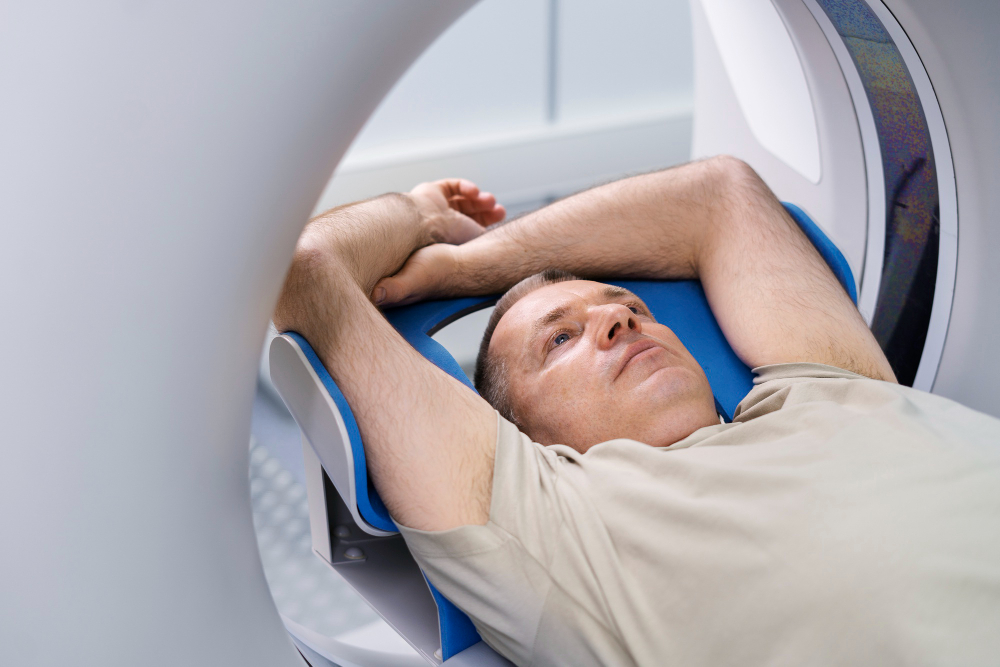
Knowledge Center

Select Speciality
| 24 November 2025
Undergoing radiation therapy can be both physically and emotionally demanding. It’s an essential part of cancer treatment, aimed at killing cancer cells and preventing them from spreading. However, the process often affects healthy cells, leading to various temporary side effects. Understanding these effects and learning how to manage them can help you stay strong and continue treatment effectively. Let’s explore practical strategies, expert guidance, and emotional support systems that can help you navigate this phase confidently.
Radiation therapy, or radiotherapy, is one of the most effective tools in modern oncology. It uses controlled doses of high-energy particles to destroy cancer cells and prevent them from growing. The treatment can be external or internal, depending on the tumor’s location and type. Knowing how it works helps patients appreciate its purpose and better prepare for possible side effects.
Radiation therapy targets the DNA of cancer cells, disrupting their ability to divide and multiply. Over time, these damaged cells die and are naturally removed by the body. Healthy cells nearby are also affected but can usually repair themselves more efficiently. This balance between killing cancer cells and preserving normal tissue is what makes radiotherapy highly effective yet delicate.
Radiotherapy is used to treat a wide range of cancers, including breast, prostate, lung, brain, and cervical cancer. Each type requires a specific radiation dose and delivery method. For example, brain tumors may respond well to stereotactic radiosurgery, while cervical cancer is often treated with brachytherapy. This personalized approach ensures that patients receive maximum benefit with minimal side effects.
Side effects can vary depending on where radiation is applied. Managing them early ensures that your treatment remains uninterrupted and effective. Addressing discomfort promptly through lifestyle adjustments, medications, or skincare prevents complications and supports faster recovery. The more informed and proactive you are, the better your treatment journey will be.
Radiation therapy isn’t one-size-fits-all. Modern oncology offers several techniques that deliver radiation with precision, minimizing damage to healthy tissues. Each method serves a unique purpose and is selected based on the tumor’s size, type, and location. Let’s look at some of the most common and advanced types used today.
External beam radiation therapy (EBRT) is the most common form of radiotherapy, where high-energy beams are directed at the tumor from outside the body. Advanced imaging allows doctors to target the tumor from multiple angles, ensuring accuracy. Side effects such as skin redness or fatigue are usually mild and temporary, fading after treatment ends.
Stereotactic radiosurgery delivers highly focused radiation to small, defined areas, typically for brain or lung tumors. The process is painless and incredibly precise, often requiring fewer sessions than traditional methods. Patients benefit from faster recovery and lower risk of complications because the radiation spares surrounding healthy tissues.
Brachytherapy involves placing radioactive material directly inside or next to the tumor. This method provides high radiation doses locally, ideal for prostate, cervical, or breast cancers. It’s effective because it limits exposure to other parts of the body. Although patients may feel slight discomfort initially, recovery is typically quick, and results are excellent.
Your radiation oncologist is your guide throughout your cancer treatment. They plan, monitor, and adjust your therapy to ensure the best possible outcome. Building a strong relationship with your doctor helps you better understand your treatment and manage side effects effectively. Their expertise is critical to balancing precision and care.
A radiation oncologist is a medical specialist trained to use radiation safely and effectively to treat cancer. They oversee every detail—from calculating doses to monitoring progress. Their role is not limited to administering radiation; they also help you manage symptoms, answer questions, and ensure you feel supported throughout the journey.
No two cancers are alike, and neither are the treatment plans. Your oncologist designs a strategy tailored to your diagnosis, health, and preferences. This customized approach minimizes side effects and enhances treatment success. Personalized plans reflect the latest research and technologies to deliver safe, effective care.
Keeping an open dialogue with your radiation oncologist and care team helps ensure early detection of any side effects. Reporting fatigue, skin changes, or appetite loss promptly allows doctors to make timely adjustments. This collaboration fosters trust and ensures a smoother treatment experience.
Every patient reacts differently to radiation therapy. Some experience mild symptoms, while others notice more pronounced changes. Understanding these side effects prepares you to manage them better and seek help early. Most side effects are temporary and fade as your body heals after treatment.
Skin irritation is one of the most visible side effects. You might notice redness, dryness, or peeling in the treated area. Using gentle, fragrance-free moisturizers and avoiding sun exposure helps ease discomfort. With proper care, skin usually returns to normal within a few weeks. If irritation worsens, your doctor may recommend medicated creams or cooling gels to soothe inflammation.
Fatigue during radiotherapy is common due to the body’s effort to repair itself. Try to rest more often and maintain a consistent sleep schedule. Light physical activity such as walking or stretching can also help you regain energy and improve your mood. Listening to your body is key: push when you can, pause when you must.
Patients receiving abdominal radiation might experience nausea, diarrhea, or appetite loss. Eating smaller, frequent meals and avoiding spicy foods can reduce these symptoms. Drinking plenty of fluids also helps the digestive system function smoothly. Adding probiotics and bland foods like rice or bananas can soothe irritation in your gut.
Radiation therapy targets cancer cells but can also affect nearby healthy tissue. This temporary impact leads to side effects. Understanding why these changes occur helps you cope more effectively. Most importantly, they’re manageable and usually disappear after therapy concludes.
Healthy cells can get caught in the radiation zone, leading to mild irritation or fatigue. However, they recover faster than cancer cells. The human body has an incredible capacity to repair itself, which is why side effects fade gradually after treatment. Most modern therapies aim to target tumors precisely, reducing exposure to normal tissue.
Short-term effects like redness or tiredness usually resolve soon after therapy. In rare cases, long-term effects may appear months later, such as stiffness or minor scarring. Discussing potential risks with your doctor helps set realistic expectations and preventive measures. Your care team may schedule follow-up imaging or physical therapy sessions to monitor recovery.
Tracking your daily symptoms helps your medical team respond quickly to any changes. Early intervention, like dose adjustments or skincare recommendations, keeps your treatment safe and more comfortable. Keeping a symptom diary can make it easier to identify patterns or triggers. Your radiation oncologist will use this feedback to fine-tune your care plan.
Your skin is one of the most sensitive areas affected by radiation therapy. Proper skincare can significantly reduce irritation and promote healing. Following your doctor’s advice and using gentle products can make a big difference during and after treatment.
Use mild, fragrance-free cleansers and avoid scrubbing the treated area. Moisturize regularly to prevent dryness, but only with doctor-approved lotions. This gentle care routine helps your skin recover faster and prevents infections. It’s best to apply moisturizer at least twice a day to maintain hydration.
Exposure to sunlight can aggravate sensitive skin. Always cover the treated area when stepping outside and avoid tight clothing that causes friction. Simple habits like these protect your skin and reduce irritation. Consider using loose cotton garments that allow airflow. If you must go outdoors, use an umbrella or soft fabric rather than sunscreen unless your doctor approves it.
Even after completing therapy, continue with your skincare regimen. Your skin may need several weeks to fully heal. Patience and consistency are key to restoring smooth, healthy skin. Keep monitoring for any unusual redness, swelling, or blisters and report them promptly. As your skin regenerates, you’ll notice less dryness and greater comfort.
Fatigue is one of the most common complaints during cancer treatment. The body’s repair process and radiation’s impact on healthy cells can make you feel drained. The right mix of rest, nutrition, and movement can help restore your energy levels naturally.
Complete rest might feel necessary, but moderate activity helps more. Simple stretches, yoga, or slow walks improve circulation and energy. Aim for balance—listen to your body, but avoid long periods of inactivity. Gentle exercise boosts endorphins, helping you feel more positive and alert.
Your meals should be nutrient-rich and easy to digest. Focus on whole grains, leafy greens, and lean proteins. Staying hydrated supports your metabolism and helps your body recover faster from fatigue. Incorporating small snacks like nuts, yogurt, or fruits between meals keeps your blood sugar stable.
Stress drains energy. Practice mindfulness or breathing exercises to relax your mind. Even short meditation sessions can restore focus and emotional calm, reducing fatigue significantly. Try visualization or gentle music to create a sense of peace before sleep. Emotional resilience plays a major role in recovery—your mindset can influence your energy just as much as nutrition does.
Finding the right care center can influence your recovery journey. The best radiation oncology hospital in Mumbai should offer advanced technology, compassionate specialists, and holistic care. A good hospital treats you as a person, not just a patient. Beyond medical precision, emotional comfort and consistent support define a truly exceptional cancer care experience.
Look for hospitals equipped with cutting-edge machines, such as IMRT or image-guided therapy. Experienced oncologists and supportive nursing staff make the process smoother and safer. A well-organized facility ensures shorter waiting times and personalized attention. Reputation matters too—research hospital success rates and patient testimonials.
New technologies like proton therapy deliver radiation precisely, minimizing side effects. Hospitals with advanced systems ensure more effective, targeted treatments with faster recovery times. These innovations also reduce damage to surrounding healthy tissues, improving overall quality of life.
What to Expect in Radiation Therapy for Cancer Treatment
The best hospitals go beyond medical care, they provide nutritional guidance, emotional counseling, and rehabilitation programs. This whole-person care ensures comfort and confidence throughout treatment. Having access to psychologists, physiotherapists, and dietitians within the same facility creates a seamless healing environment.
Radiation therapy may test your strength, but it also showcases your resilience. By understanding side effects and managing them with expert support, nutrition, and mindfulness, you can turn this challenge into a journey of healing. Remember, recovery isn’t just about surviving, it's about thriving through courage, care, and compassion.
Most side effects resolve within weeks after treatment, depending on the targeted area and dosage.
Yes, but it depends on your energy levels and the treatment site. Light work is usually manageable.
No, radiation is painless, though mild fatigue or skin irritation can occur temporarily.
All Copyrights Reserved. © 2025 Jaslok Hospitals | Managed by Digimanic